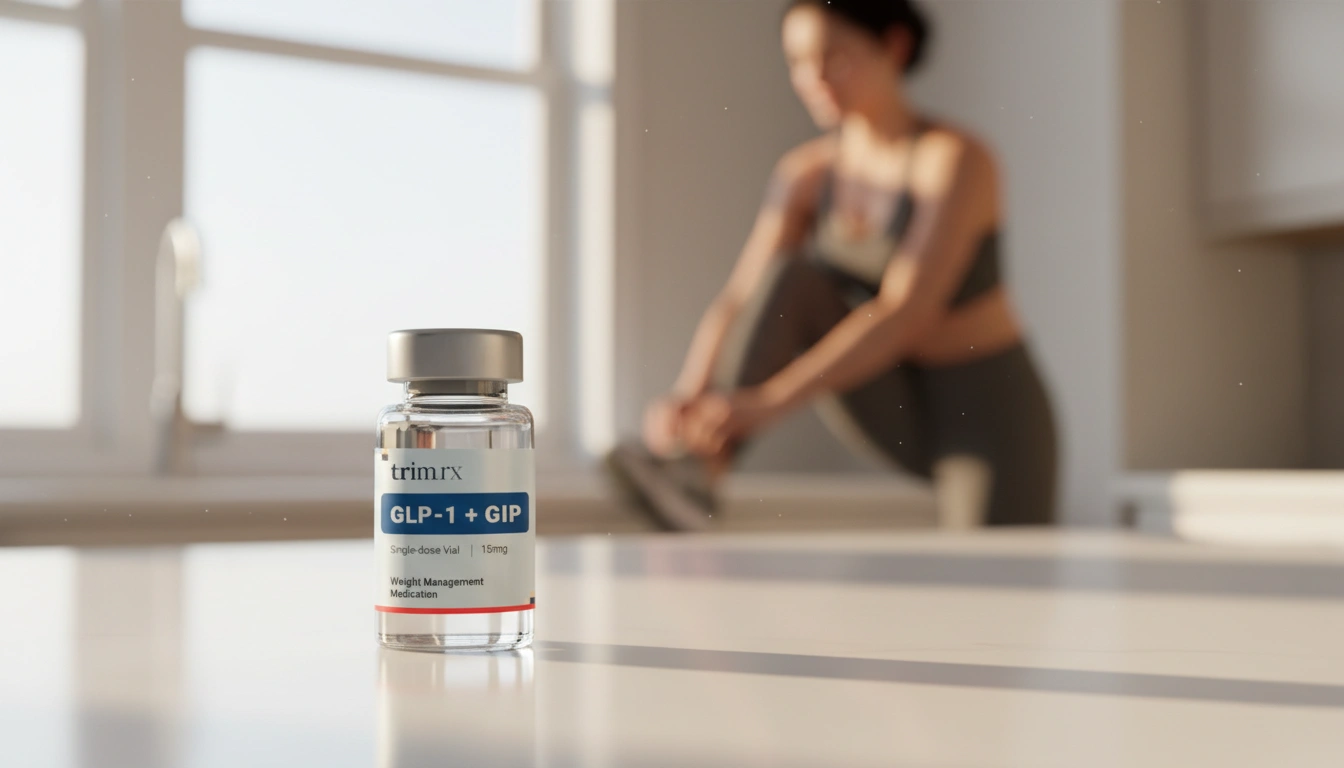How to Get Rid of Nausea from GLP-1 Medications: Practical Tips for Relief

Introduction
Did you know that approximately 20% of individuals taking GLP-1 medications, such as Semaglutide and Tirzepatide, report experiencing nausea? This statistic highlights a common challenge that many face when embarking on their weight loss journey with these medications. While GLP-1 (glucagon-like peptide-1) medications have gained popularity for their effectiveness in managing weight and controlling blood sugar levels, they can also bring about some uncomfortable side effects, particularly gastrointestinal issues like nausea.
As a leader in personalized weight loss solutions, we at TrimRx understand that navigating these side effects can be daunting. Our mission is to empower individuals with the knowledge and support they need to achieve sustainable weight loss while minimizing discomfort. In this blog post, we will explore effective strategies on how to get rid of nausea from GLP-1 medications, ensuring that your experience is as smooth as possible.
We will discuss the reasons behind nausea when using GLP-1 medications, practical dietary adjustments, timing of medication, and lifestyle changes that can help alleviate symptoms. By the end of this article, you will have a comprehensive understanding of effective strategies to manage nausea, enabling you to stay focused on your weight loss goals.
Understanding GLP-1 Medications and Their Side Effects
GLP-1 medications, such as Ozempic® and Wegovy®, work by mimicking the effects of the natural hormone glucagon-like peptide-1. This hormone plays a crucial role in regulating appetite, promoting feelings of fullness, and slowing gastric emptying. While these actions can be beneficial for weight management and blood sugar control, they can also lead to gastrointestinal side effects, including nausea.
Why Does Nausea Occur?
Nausea is often most pronounced during the initial phase of treatment or following a dosage increase. The body’s adjustment to the medication can trigger gastrointestinal discomfort. Research indicates that nausea typically peaks within the first few days or weeks of starting treatment and may decrease in severity as the body acclimatizes. However, for some, nausea can persist longer, making it essential to have effective management strategies in place.
Duration of Nausea
Most individuals experience nausea for a limited duration, with symptoms often subsiding within the first seven to ten days. However, for those who continue to experience nausea beyond this period, it is crucial to consult with a healthcare provider. They may suggest dosage adjustments or alternative medications that could be better tolerated.
Dietary Adjustments for Nausea Relief
One of the most effective ways to combat nausea from GLP-1 medications is through dietary modifications. What you eat, when you eat, and how you consume your meals can significantly impact your comfort level.
1. Eat Smaller, More Frequent Meals
Instead of three large meals, consider breaking your daily intake into five to six smaller meals. This approach can help manage hunger signals and reduce the risk of overwhelming your digestive system, ultimately minimizing nausea.
2. Choose Blander Foods
Opt for bland, easily digestible foods that are less likely to irritate your stomach. Foods such as plain rice, bananas, applesauce, and toast can provide sustenance without exacerbating nausea.
3. Stay Hydrated
Dehydration can worsen feelings of nausea, so it’s essential to maintain adequate fluid intake. Aim to drink at least 64 ounces of water daily. Herbal teas, clear broths, and electrolyte drinks can also be beneficial for hydration.
4. Incorporate Ginger or Peppermint
Ginger and peppermint are natural remedies known for their anti-nausea properties. Consider sipping ginger tea or consuming ginger candies. Similarly, peppermint tea can help soothe your stomach and alleviate nausea.
5. Avoid Trigger Foods
Identifying and avoiding foods that trigger nausea is crucial. Fatty, spicy, or excessively sweet foods can exacerbate symptoms, so it may be helpful to keep a food diary to track what works for you.
Timing of GLP-1 Injections
The timing of your GLP-1 medication can significantly influence the occurrence of nausea. Here are some strategies to consider:
1. Experiment with Timing
Some individuals find that taking their injection at a specific time of day—either in the morning or evening—helps manage nausea. If you notice that nausea tends to occur after your injection, try adjusting the timing to see if it makes a difference.
2. Rotate Injection Sites
While there is limited scientific evidence to support this, some patients report reduced nausea by rotating their injection sites. If you typically inject in your abdomen, consider trying your thigh or upper arm to see if it makes a difference in your comfort levels.
Lifestyle Changes to Alleviate Nausea
In addition to dietary adjustments and timing strategies, certain lifestyle changes can help ease nausea symptoms associated with GLP-1 medications.
1. Practice Mindfulness and Relaxation Techniques
Stress and anxiety can exacerbate feelings of nausea. Incorporating mindfulness practices, such as deep breathing exercises, meditation, or gentle yoga, can help calm your mind and body, potentially reducing nausea symptoms.
2. Engage in Gentle Physical Activity
While it might seem counterintuitive, light physical activity, like walking or stretching, can aid digestion and alleviate nausea. Aim to incorporate low-impact exercises into your routine to stimulate your gastrointestinal system.
3. Maintain a Healthy Sleep Schedule
Adequate rest is essential for overall well-being. Prioritize sleep hygiene by establishing a regular sleep schedule, creating a comfortable sleep environment, and avoiding screens before bedtime to ensure restorative sleep.
4. Consult with a Healthcare Provider
If nausea persists despite implementing these strategies, it’s important to consult with your healthcare provider. They may recommend prescription anti-nausea medications like ondansetron or metoclopramide to help manage symptoms effectively.
When to Reach Out for Help
While nausea is a common side effect of GLP-1 medications, there are instances when you should consult your healthcare provider for further guidance:
- If nausea is severe or persistent and affects your daily life.
- If nausea is accompanied by other concerning symptoms, such as severe abdominal pain, vomiting, or diarrhea.
- If you experience signs of dehydration, such as dizziness, dry mouth, or infrequent urination.
By maintaining open communication with your healthcare provider, you can ensure that you receive the support and adjustments necessary to manage your treatment effectively.
Conclusion
Navigating the side effects of GLP-1 medications, particularly nausea, can be challenging; however, with the right strategies, it is manageable. By making thoughtful dietary adjustments, experimenting with medication timing, and incorporating lifestyle changes, you can alleviate nausea and continue on your path toward successful weight loss and improved health.
At TrimRx, we are committed to supporting you throughout your weight loss journey. Our personalized weight loss programs, including the opportunity to take our free assessment quiz, can help you find the right weight loss solution tailored to your unique needs. If you haven’t already, consider taking our free assessment quiz to see if you qualify for our prescription weight loss medications.
If you are looking for immediate support during your weight loss journey, explore our quick-access supplements, such as our GLP-1 Daily Support and Weight Loss Boost. These products are designed to complement your efforts and enhance your overall wellness.
By taking proactive steps and utilizing the right strategies, you can successfully manage nausea from GLP-1 medications and stay focused on achieving your health and weight loss goals.
FAQ
What is nausea, and why does it occur with GLP-1 medications?
Nausea is a feeling of discomfort in the stomach that can lead to the urge to vomit. It often occurs with GLP-1 medications due to their effects on the digestive system, particularly their ability to slow gastric emptying.
How long does nausea last when taking GLP-1 medications?
Nausea typically peaks within the first few days or weeks of treatment and usually subsides within 7 to 10 days. If nausea persists beyond this, consulting a healthcare provider is recommended.
What dietary adjustments can help relieve nausea?
Eating smaller, more frequent meals, choosing bland foods, staying hydrated, and incorporating ginger or peppermint can all help alleviate nausea.
When should I talk to my healthcare provider about nausea?
Reach out to your healthcare provider if nausea is severe, persistent, or accompanied by other concerning symptoms such as severe abdominal pain or signs of dehydration.
Are there any medications for nausea relief?
Yes, over-the-counter options like Dramamine or prescription medications such as ondansetron may be recommended to help manage nausea symptoms. Always consult your healthcare provider before starting any new medication.

Transforming Lives, One Step at a Time
Keep reading
Vitamin B12 and GLP-1 Medications: What to Know
GLP-1 medications can lower B12 absorption and intake; learn symptoms, food sources, supplement options, and how to monitor levels.
Semaglutide Injection Site Reactions: What To Know
Learn why semaglutide injections can cause redness, swelling or nodules, how to prevent and treat them, and when to seek medical care.
TrimRx vs Friday’s
Compare TrimRx and Friday’s telehealth GLP-1 weight-loss programs: pricing, medical support, coaching, delivery, and which fits your needs.



